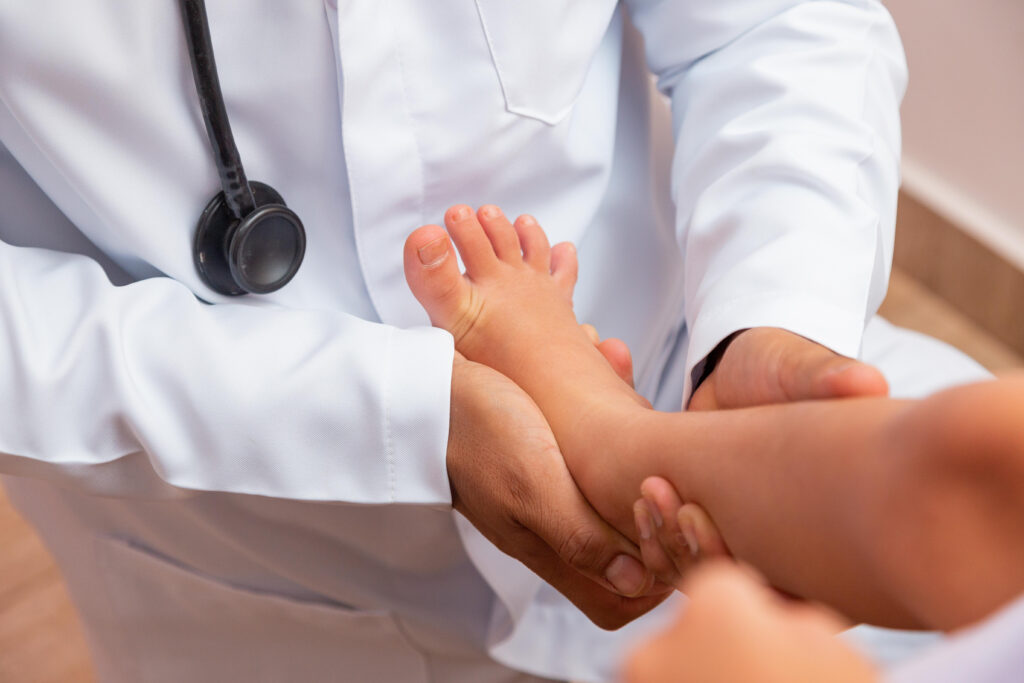What is Osgood-Schlatter Disease?
Osgood-Schlatter disease is a common condition that results from overuse. It causes swelling of the kneecap tendon as it inserts into the cartilage of the shin (the tibia). Medically speaking, it is an inflammatory disease of the growth plate at the top of the shin. Growth plates are the area of new bone growth in children and teens and are made of soft cartilage until your child stops growing, at which point the tissue hardens into bone.
Osgood-Schlatter disease in children generally affects rapidly growing preadolescents and teens, commonly 10-14 years old. The condition can occur in any child while they are still growing and their growth plates are open. It shows up in around 10% of student athletes.
Osgood-Schlatter disease can last between one and two years but in most cases, it goes away on its own when your child stops growing. However, you should prepare for flare-ups during growth spurts.
Identifying Osgood-Schlatter Disease
Osgood-Schlatter disease symptoms center around a painful bump on the front of the shin just below the kneecap. You may see swelling or notice the bump is enlarged if your child has been experiencing Osgood-Schlatter disease for a few months.
Although each child may experience Osgood-Schlatter disease symptoms differently, parents should be aware of the following signs:
- Tenderness below the knee.
- Your child feels pain intermittently or constantly in one or both knees.
- The discomfort is more acute when the knee is completely bent or completely extended.
- Walking up or down stairs or engaging in high-impact sports (such as track & field activities, soccer, basketball, and gymnastics) is painful.
- Swelling around the knee.
- Your child is limping, particularly after physical activities.
Because the symptoms may resemble other musculoskeletal conditions affecting the knee, it’s important to bring your child in for an examination and diagnosis as soon as you notice these changes.
What causes Osgood-Schlatter Disease?
The key cause of Osgood-Schlatter disease is open growth plates near the ends of long bones such as the thighbone (femur) and lower legs (tibia and fibula).
In tweens and young adolescents, children’s bones usually grow faster than their muscles and tendons do. This can lead to tight muscles and tendons in the thighs (quadriceps in front and hamstrings in the back). When active kids engage in activities or sports that involve running and jumping, or even a lot of stair climbing, there’s a constant pulling of the tendon area below the knee (patellar tendon). This causes Osgood-Schlatter disease—and is a big reason why we see the condition in many young athletes. In some children, poor muscle flexibility is another contributing factor.
Diagnosing Osgood-Schlatter Disease
If you notice the signs of Osgood-Schlatter disease, your child’s physician should do a complete physical examination. At TPOC, we use radiology when diagnosing Osgood-Schlatter disease—and to rule out any other conditions that are causing your child pain. We take a knee X-ray first and then might do a bone scan to look for any degenerative changes in the knee joint and/or an MRI for more detailed images.
Treating Osgood-Schlatter Disease
Osgood-Schlatter disease treatment focuses on one goal: to control your child’s knee pain by limiting the activities that make it worse.
Because tight muscles contribute to Osgood-Schlatter disease, we recommend exercises to stretch the hamstrings and quadriceps as part of the treatment. If your child is experiencing a lot of pain and/or limping, resting the leg is crucial. Avoiding activities that involve running and jumping will help alleviate your child’s discomfort.
Other Osgood-Schlatter disease treatment measures are:
- Using a knee immobilizer, brace, or cast.
- Applying ice to the area to reduce pain.
- Low-impact cross-training activities for student-athletes (walking, biking, and swimming are great examples).
- Anti-inflammatory medications per your clinician’s prescription.
It is rare that any patient requires surgery for the condition, which is normally used for only a tiny percentage of fully-grown patients who develop calcium deposits in the affected tendon (to remove the deposits). Some adults end up with a permanent bump at the top of the tibia that may be sensitive to pressure.
Checking for Osgood-Schlatter Disease at TPOC
As noted in a prior post, Osgood-Schlatter disease is among several conditions that seem like “growing pains” that affect young athletes and active kids. If your child is experiencing persistent pain below the knee (or in any joint) or other symptoms noted above, please don’t wait for the symptoms to subside. Contact The Pediatric Orthopedic Center for a consultation so our orthopedists can verify the source of your child’s discomfort and recommend the most effective treatment.




